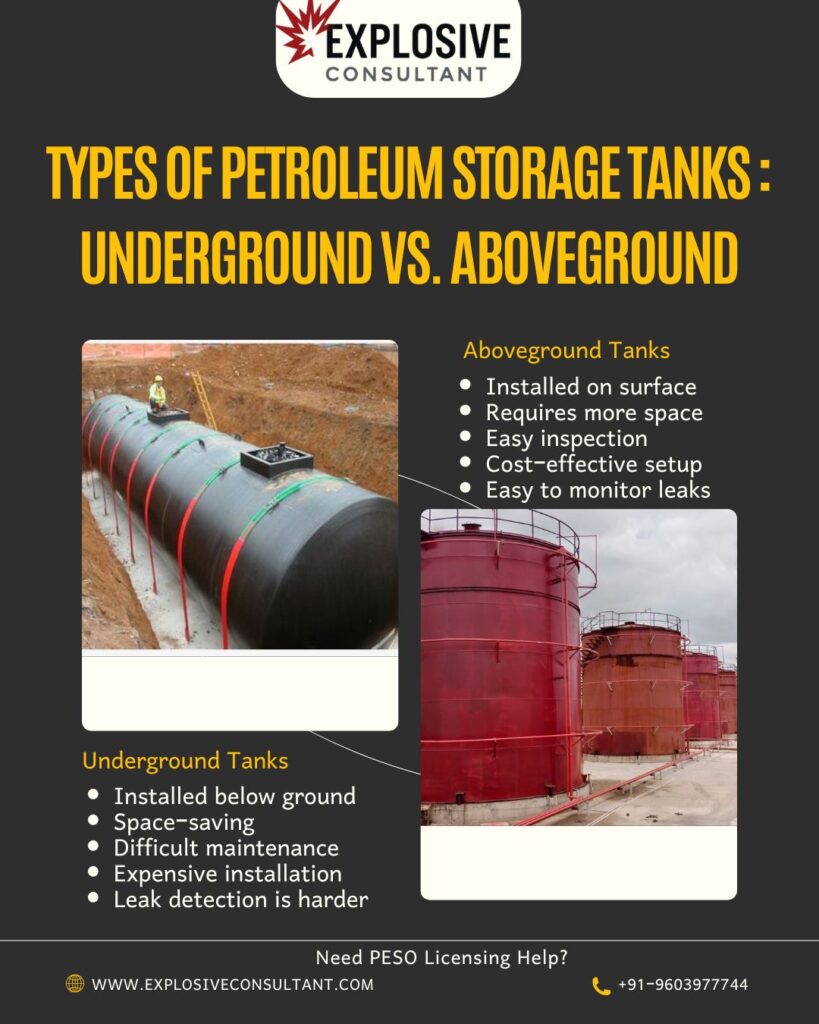Introduction
Petroleum storage tanks play a crucial role in storing fuels like diesel, petrol, and HSD (High-Speed Diesel) for commercial, industrial, and transportation use. In India, these tanks must comply with the guidelines set by the Petroleum and Explosives Safety Organization (PESO). Choosing the right tank—underground or aboveground—depends on safety, space, compliance, and operational needs.
What Are Petroleum Storage Tanks?
Petroleum storage tanks are specialized containers designed to store flammable liquids like diesel, petrol, kerosene, and other fuels. These tanks are governed by the Petroleum Rules, 2002 and require proper licensing from PESO to operate legally in India. Based on installation type, storage tanks are broadly classified into:
- Underground Storage Tanks (USTs)
- Aboveground Storage Tanks (ASTs)

Underground Storage Tanks (USTs)
Underground tanks are buried below the earth’s surface and are commonly used in petrol pumps and space-restricted industrial areas.
Advantages:
- Saves space
- Safer from weather exposure and physical damage
- Aesthetic – doesn’t affect landscape visibilty
Disadvantages:
- High installation and excavation cost
- Difficult to detect leaks
- Costly maintenance and inspection
Aboveground Storage Tanks (ASTs)
Aboveground tanks are installed on the surface and are widely used in factories, agricultural facilities, and bulk fuel stations.
Advantages:
- Easy to install, inspect, and maintain
- Lower cost compared to USTs
- Easier to detect leaks or corrosion
Disadvantages:
- Needs more space
- Vulnerable to weather and external damage
- May require shielding or containment walls
Comparison Table: Underground vs. Aboveground Tanks
| Feature | Underground Tanks (USTs) | Aboveground Tanks (ASTs) |
| Installation Cost | Higher | Lower |
| Space Saving | Yes | Yes |
| Maintenance | Difficult | Easy |
| Leak Detection | Complex | Simple |
| Weather Protection | Good | Requires shielding |
| PESO Licensing | Required | Required |
Regulations and PESO Compliance
Whether you choose a UST or AST, both must follow PESO regulations:
- Site layout approval
- Fire NOC from local authorities
- Use of certified tanks (as per IS standards)
- Proper venting, earthing, and hazard signage
- Leak detection systems for underground tanks
Industry Usage & Suitability
- USTs: Fuel stations, city-based facilities, limited space areas
- ASTs: Transport depots, rural fuel storage, industrial operations
Choose the tank based on safety, land availability, maintenance flexibility, and PESO documentation.
Conclusion
Choosing between an underground or aboveground petroleum storage tank depends on your operational needs, compliance requirements, and budget. Both have pros and cons, but in all cases, PESO licensing is a must. For guidance on PESO approvals, tank installation, or fuel safety standards, consult a certified explosive consultant.
